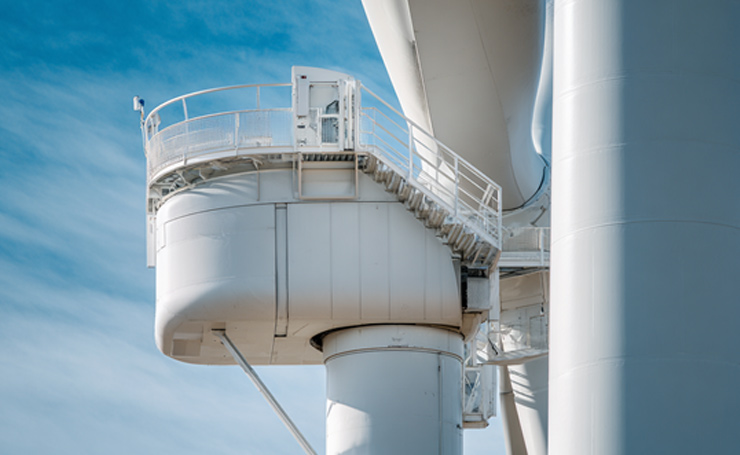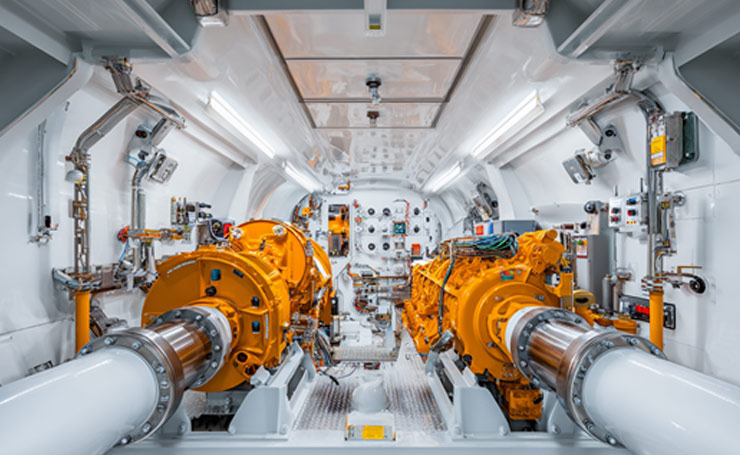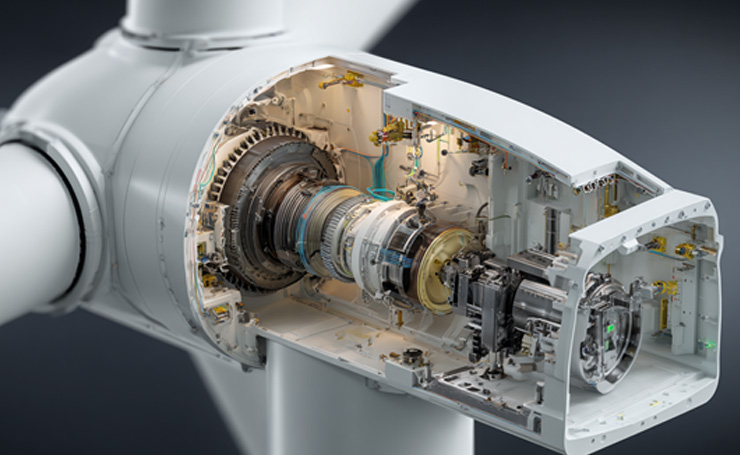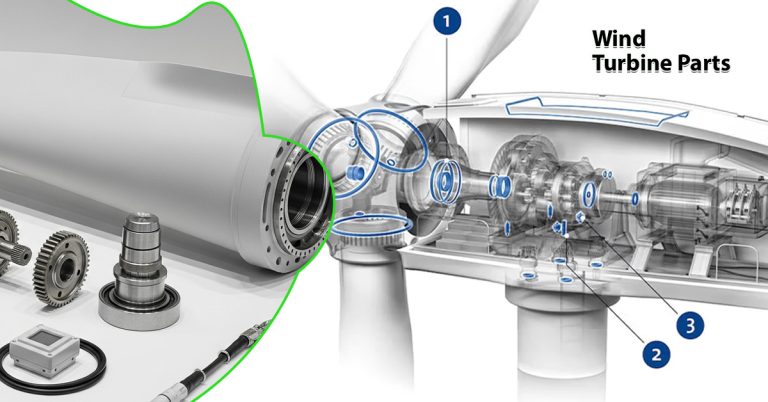20-Second Summary
Wind turbine parts are related to a wind turbine, which transforms the kinetic energy of moving air into electricity through a series of mechanical and electrical components.
The main wind turbine parts include
- The Rotor (blades and hub)
- Shafts
- Gearbox
- Generator
- Nacelle
- Tower
- And Foundation
Along with these main parts, it also includes the supporting systems that help the turbine to operate efficiently and safely in varying wind situations, these include the parts like:
- The pitch system
- The Yaw system
- The Brake
This guide about wind turbine components will cover in detail the functioning of each part and its support system.
How a Wind Turbine Works
The operation of the wind turbines is really simple.

- When the wind moves, it turns the blades of the turbine, and this rotation helps to generate electricity.
- When the wind starts flowing, the rotor blades start moving, and this creates an aerodynamic lift that makes them spin around the hub.
- This hub is further connected with a low-speed shaft inside the wind turbine part known as the nacelle, which transfers this mechanical energy into the gearbox.
- The gearbox then increases the rotational speed and drives the high-speed shaft connected to the generator.
- Till reaching the energy, the kinetic energy from the wind is just mechanical energy, which gets converted into electrical energy by the generator.
- This electricity flows through the power electronics, electrical wiring, and transformers, which adjust voltage levels before sending it to the grid.
Then comes the functioning of the Supporting systems

- These systems, like the pitch system, yaw system, and braking system, help to maintain optimal performance and protect the turbine from damage.
Together, these wind turbine components and the supporting system components work seamlessly to convert natural wind into reliable, renewable power.
Main Structural Components
Now that we have gone through a quick working of the parts of a wind turbine, let us have a detailed look at the functioning of each part individually, to see how they work together to capture wind and convert it into usable energy.

Rotor / Blades / Hub
- The rotor is one of the most crucial parts of a wind turbine.
- It includes the blades and the hub, which together capture the wind’s kinetic energy.
- Modern wind turbines have three aerodynamic blades designed to maximize lift and minimize drag for a smooth rotation.
- Each blade is made of lightweight composite materials like fibreglass and carbon fibre to withstand wind loads while keeping the system efficient.
- As the wind passes over the rotor blades, lift is generated, which causes the hub to spin,
- The hub sits at the centre of the rotor, connecting all blades and transferring their rotational motion to the main shaft.
- This hub connects the blades to the main shaft inside the nacelle.
- It transforms the rotational motion generated by the blades to the drivetrain.
- Some modern hubs also have pitch control mechanisms that help to adjust blade angles to maintain safe operation during strong winds.
Shafts: Low-speed (main) and High-speed
The shafts are essential wind turbine internal components.
They transmit the mechanical energy from the rotor to the generator.
There are two main types:
- The low-speed shaft (main shaft) connects directly to the rotor hub. It rotates slowly but carries high torque.
- The high-speed shaft connects to the generator and spins much faster (often over 1,500 revolutions per minute) after the torque passes through the gearbox.
These main turbine parts are supported by rotor bearings that minimize friction and ensure efficient power transfer.
The reliability of the shafts and bearings is crucial for long-term turbine performance.
Gearbox
- The gearbox links the low-speed shaft to the high-speed shaft and increases the rotational speed of the low-speed shaft to match the generator’s operating speed.
- For example, a rotor turning at 20 RPM may be increased by the gearbox to around 1,500 RPM for efficient electricity generation.
- Gearboxes contain multiple gears arranged in stages, planetary, helical, or spur gears, to handle varying loads.

- However, we now also have direct-drive turbines that eliminate the gearbox altogether, connecting the rotor directly to the generator to reduce maintenance and mechanical losses.
- Because the gearbox experiences high stress and friction, it’s one of the most monitored wind turbine components.
- It has temperature and vibration sensors that continuously monitor the gearbox’s condition and send data to the control system for predictive maintenance.
Generator
- The generator is the most vital part of the wind turbine, which converts the mechanical rotation of the high-speed shaft into electrical energy.
- Today, the modern turbines use synchronous or induction generators, depending on design and grid requirements.
- When the rotor turns, mechanical power spins the generator’s rotor.
- This creates the electromagnetic induction that produces electricity.
- This electricity is then regulated by power electronics and sent through the electrical wiring and transformer for voltage adjustment.
- A good generator ensures the proper functioning of a wind turbine, and proper cooling systems and regular maintenance ensure stable and long-term performance.
Nacelle
- The nacelle is the protective housing located at the top of the tower.
- It encloses the main turbine components, including the gearbox, generator, low-speed and high-speed shafts, brake system, and control system.
- The nacelle is built from durable materials.
- It shields these internal wind turbine parts from harsh weather while allowing maintenance access through hatches or service doors.

- Inside the nacelle, the integrated sensors and controllers monitor performance, temperature, and vibration levels.
- The nacelle also connects to the yaw system, enabling the turbine to rotate and face the wind direction for maximum efficiency.
Tower
- The tower supports the nacelle and rotor at an optimal height where wind speeds are higher and more consistent.
- It is made from tubular steel.
- Some large-scale or offshore turbines also use hybrid concrete-steel towers.
- Taller towers capture stronger and steadier winds.
- Inside the tower, you’ll find ladders, electrical wiring, and sometimes elevators that help technicians reach the nacelle for maintenance.
- The tower also acts as a structural support, ensuring the turbine can withstand strong winds, vibrations, and dynamic loads.
Foundation
- The foundation anchors the entire wind turbine structure to the ground or seabed.
- It is designed in a way that it can resist enormous static and dynamic forces generated by the tower, nacelle, and rotor.
- Onshore turbines typically use concrete gravity foundations.

- The offshore turbines rely on floating platforms depending on water depth.
- A well-engineered foundation ensures stability, safety, and long operational life for the entire support structure of the turbine.
Control & Supporting Subsystems
The wind turbine’s main parts function together to convert the kinetic energy into electrical energy, but the control and supporting subsystems ensure that the turbine operates efficiently, safely, and continuously.
- These systems constantly adjust to the direction of the winds and changes in the speed.
- They help to protect the structure and optimize power output.
Pitch System
- The pitch system is an important wind turbine component that controls the angle of the blades.
- By rotating each blade around its longitudinal axis, the pitch system regulates how much wind force acts on the rotor.
- When wind speeds are low, the blades pitch to catch more wind, maximizing energy production.
- During strong winds, they pitch out of the wind to reduce load and prevent damage.
- This process helps maintain safe rotor speeds and stable electricity generation.
- Pitch control is achieved either hydraulically or electrically, with sensors and actuators constantly receiving input from the control system.
- The pitch system is crucial for both performance optimization and turbine safety.
Yaw System
- The yaw system ensures the nacelle and rotor always face the wind for maximum energy capture.
- It automatically rotates the entire top structure using yaw motors, yaw bearings, and a large yaw drive mechanism located at the top of the tower.
- When the wind vane detects a change in wind direction, the control system signals the yaw motors to adjust the nacelle’s position.

- This alignment process minimizes energy losses caused by off-axis wind flow and prevents unnecessary mechanical stress on the blades and shafts.
- Without an effective yaw system, turbines would face efficiency drops and increased wear on key wind turbine parts.
Control System & Sensors
The control system is the brain of the wind turbine.

- It continuously monitors and manages every internal turbine component.
- It makes sure that the performance and safety of the turbine are at an optimal level.
- It gathers real-time data from various sensors, including:
- Anemometer: measures wind speed.
- A wind vane is the sensor that detects the direction of the wind.
- Temperature and vibration sensors help to track component health.
- Strain gauges: measure stress on blades and tower.
Based on this data, the controller adjusts the pitch, yaw, and brake systems to maintain ideal operating conditions.
If wind speeds exceed safety thresholds, the control system automatically initiates braking or shutdown.
Brake System
The brake system is a safety-critical wind turbine part designed to stop the rotor when necessary.
Braking is required during extreme winds, grid failures, or maintenance activities.

There are two types of braking mechanisms:
- Mechanical or hydraulic brakes are used during emergencies, and they are mounted on the high-speed shaft.
- Aerodynamic brakes act by pitching the blades out of the wind to reduce lift and slow the rotor naturally.
Most modern turbines combine both braking types for maximum safety.
The control system engages the brakes automatically when sensors detect overspeed or excessive vibration, preventing mechanical damage to the gearbox, generator, and shafts.
Electrical Wiring, Power Electronics & Transformer
After the generator converts mechanical energy into electricity, the power passes through internal electrical wiring, power electronics, and a transformer before being delivered to the grid.
Power Electronics
- Power electronics regulate current and voltage.
- They ensure consistent output despite varying wind speeds.
- Variable-speed turbines use inverters and converters to maintain grid-quality electricity.
Transformer
- The transformer is located at the turbine base or nearby substation
- It steps up the voltage to meet transmission requirements.
Proper insulation, grounding, and monitoring of electrical components are essential for safety and efficiency.
These systems together make sure that energy produced by the wind turbine parts is stable, grid-compatible, and efficiently transmitted.
Integration: How All Parts Work Together
All wind turbine parts work in harmony to convert moving air into clean electricity. Here’s how the process flows step by step:

- Blades capture wind energy and spin the rotor.
- The hub transfers this rotation to the low-speed shaft inside the nacelle.
- The gearbox increases the rotation speed and drives the high-speed shaft.
- The generator converts mechanical motion into electrical energy.
- Power electronics and transformers regulate and transmit the electricity to the grid.
- The pitch system adjusts blade angles to control speed and load.
- The yaw system rotates the nacelle to face the wind direction.
- The control system and sensors monitor performance
- They also ensure safety.
- The tower and foundation provide height, balance, and structural stability.
Together, these wind turbine components create a seamless cycle that turns natural wind into reliable renewable power.
Latest Trends & Innovations
The wind energy sector continues to evolve, as the world is now focusing more on generating electricity using renewable energy resources.
Below are the key innovations shaping modern wind turbine components:
- Direct-Drive Systems have replaced the gearbox by connecting the rotor directly to the generator to reduce the maintenance needs and mechanical losses, along with noise.
- AI-powered monitoring and predictive analytics are now standard across modern wind farms, helping reduce downtime and extend turbine life.
- Now there are lightweight Composite Blades that are more durable and have less weight. These help to enhance the wind power in the low-wind areas, too.
- Modern nacelles allow easier assembly and maintenance.
- Modern towers are built of hybrid structures using steel and concrete towers to enhance the strength and stability for higher hub heights, for greater energy capture.
- Smarter inverters and transformers stabilize power quality and ensure seamless grid integration despite variable wind speeds.
- Recyclable blades, hubs, and foundations are being manufactured to minimize environmental impact and support circular manufacturing.
Final Remarks
Understanding the functioning of the main parts of a wind turbine helps to see how clean energy is produced from natural wind.
Each wind turbine component, starting from the blades and hub to the nacelle, tower, and foundation, plays a very crucial role in capturing, converting, and delivering renewable power.
Modern wind turbine systems integrate smart control systems, pitch and yaw mechanisms, and advanced power electronics to ensure maximum efficiency and safety.
With the expansion of wind energy globally, understanding these wind turbine parts and functions helps us see why this technology is central to the world’s clean energy transition.
If you wish to explore more about renewable technology, visit our blogs on What is Solar Energy? And What is Wind Energy? To learn how these systems are shaping a greener future.
Frequently Asked Questions
What are the major parts of a wind turbine?
The main parts include the rotor (blades and hub), shafts, gearbox, generator, nacelle, tower, and foundation. Each plays a vital role in generating electricity from wind.
What does the nacelle do in a wind turbine?
The nacelle has the essential wind turbine components such as the gearbox, generator, brake, and control systems. It protects these internal parts and ensures smooth energy conversion.
What is the function of the blades in a wind turbine?
They capture the kinetic energy from the wind and turn it into rotational energy that drives the rotor and generator.
What is the difference between a low-speed shaft and a high-speed shaft?
The low-speed shaft turns slowly with high torque from the rotor. The gearbox increases the speed, transferring it to the high-speed shaft that powers the generator.
Why do wind turbines have a pitch and yaw system?
The pitch system helps to change the angle of the blades to control speed and power output. The yaw system rotates the nacelle to face the wind for maximum efficiency.
What is inside a wind turbine tower?
It contains ladders, cables, and sometimes elevators that support the nacelle and rotor at a height where wind speeds are stronger and consistent.
How does the control system of a wind turbine work?
Sensors measure wind speed and direction by sending data to the controller. The control system adjusts blade pitch, yaw, and braking to maintain safe and efficient operation.

